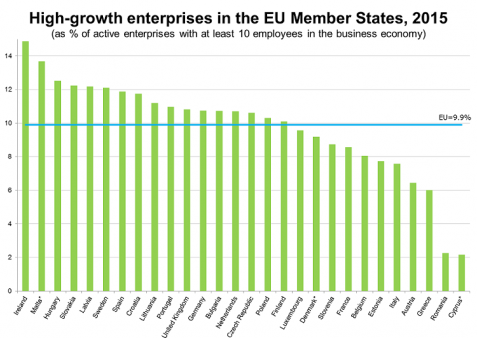Although we have been positioned at the forefront of the EU due to our economic growth over the past two years in terms of GDP growth, this notable performance has been achieved while we have a very low proportion of rapidly growing enterprises, as they are defined by Eurostat in comparable terms at the EU level.
The chart published by the EU’s statistical body looks stupefying to anyone who makes the connection with the Romania’s economic performance, although the data processed are those of 2015 according to the standardized procedures and the time needed to harmonize the results.
Why Romania is not between Hungary and Bulgaria
While approximately one in five employees worked in enterprises with a fast growth rate two years ago in Ireland (21.7%), Hungary (20.7%) and Portugal (19.7%), Romania appeared on the penultimate position with only 5.9% leaving behind only the small Cypriot economy (which had, for comparison, 3.6% calculated for 2014).
It is noteworthy that two other countries from the former socialist bloc have been positioned much ahead of us, which shows that the impact of companies with high growth dynamics also led to an impact commensurate with (that is MINOR IN OUR CASE) the increase in the number of employees. Bulgaria (18.6%) was placed right after the UK (19.0%) and Latvia equalled the Netherlands at this indicator (both with 17.4%).
At the European level, about 158,000 enterprises have been ranked as fast-growing. They accounted for almost one-tenth (9.9%) of all active businesses with at least 10 employees and offered jobs to 13.5 million people. They were identified based on an increase in the number of employees of more than 10% over three consecutive years.
The most active economic sectors were „IT&C” (15.3% of all fast-growing enterprises), „administrative and support services” (14.0%) and „professional, scientific and technical activities” (11.3%).
One way or another, we lagged behind once again in EU statistics
In our case, the first of the three best performing sectors mentioned above showed an increase of 9.5% in 2015 compared to the previous year, and the latter two, taken together in the national GDP statistics, settled for only 2.4%.
The provisional data for the first semester of the current year show the “IT&C” maintains at a high rate (+ 10.5%) and a remarkable development in the mix between „administrative and support services” and „professional, scientific and technical activities” (11.4%). That should be seen only in the data to be published by Eurostat in 2019, BUT ONLY IF that is confirmed in the final version.
For the time being, though, the distribution of fast-growing enterprises by member states is totally unfavourable to us and the highest shares in the total number of enterprises registered are in Ireland (14.9%), Malta (13.7%, with data from 2014) and Hungary (12.5%). Behind them, Slovakia and Latvia (both with 12.2%) managed to overtake Sweden (12.1%).
It is worth studying the stupefying graph below, with Romania next to the countries from where we import:
 In this context, where does Romania appear? Well, penultimate, with only 2.3%, just slightly before Cyprus (2.2%, value of 2014) and far away from the platoon of European LAGGARDS Greece (6.0%), Austria (6.5%) and Italy (7.6%), above which is positioned the first country that joined the EU more recently, Estonia (7.7%).
In this context, where does Romania appear? Well, penultimate, with only 2.3%, just slightly before Cyprus (2.2%, value of 2014) and far away from the platoon of European LAGGARDS Greece (6.0%), Austria (6.5%) and Italy (7.6%), above which is positioned the first country that joined the EU more recently, Estonia (7.7%).
Although the relationship between the number of performant enterprises and the increase in the number of newly created jobs show a relatively good capacity to create well-being based on a person’s work, it should be underlined that successes are rather isolated in the large mass of companies.
Where those struggling to survive form the clear majority, while those that are successful indeed are far from being enough. This is shown by the data from other neighbouring countries which are similar in terms of development level and which are facing or should face the same problems. The difference seems to be made by the environment where they operate, with the support of the state (in their case) or the dominating situation of throwing a spanner in the works (in our case).










